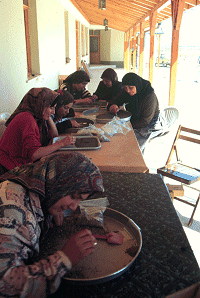An Archaeological Landscape in the Making: A View from Çatalhöyük
by Ayfer BartuThe renewed archaeological research at Çatalhöyük has been characterized as "the dig of the millennium." A site of this importance is bound to attract attention from archaeology circles. But archaeologists are not the only group of people interested in Çatalhöyük, and the excavation site itself is only one of the sites in which a particular kind of knowledge about Çatalhöyük is being produced. As any other archaeological excavation, the Çatalhöyük project is embedded within a wider social, political, cultural, and historical context, and besides the archaeologists there are multiple groups involved in the project in various ways. Being one of the social anthropologists working at Çatalhöyük project, my research focuses on these multiple groups and sites through which different kinds of knowledge about Çatalhöyük are being produced and consumed. The groups that I focus on include the local community living in the surrounding villages - some of whom are hired at the site; domestic and foreign tourists visiting the site; Goddess groups and worshippers; the local and central government officials; the fashion designers interested in the site. This "multi-sited" ethnography is an integral part of the reflexive methodology which is being used at Çatalhöyük. Multiple and often contested meanings attributed to the past and the present of this landscape provide an important example of the contemporary challenges facing the archaeologists. The competing narratives around Çatalhöyük provide crucial insights for the socially responsible and self reflexive practice of archaeology, and the wider context in which archaeological practice is embedded in.
Figure 16: The women from Küçükköy sorting the heavy residue |
One of the major aims of this research has been to engage in a dialogue with these various groups with different interests and agendas, and get them involved in the interpretation and public presentation of the site as much as possible. This also constituted the general framework of my work at Çatalhöyük in the 1998 season. My fieldwork focused on several projects: The first involved putting together a community exhibit at the visitor centre at the site. The idea behind this exhibit was to capture the different ways in which the local people relate to the ongoing archaeological research, and to the landscape in general. The group that I worked with constituted of local women who are hired at the project. The major challenge was to find a medium through which they could express their perceptions and interpretations of the project and the landscape. Photography, something that many of them enjoyed a lot, seemed to be an appropriate medium. They were given cameras and took pictures of the parts of the project and the landscape that they found interesting. Pictures were taken during the alternative tours of Çatalhöyük in which these local women were the guides. Along with the pictures that they took, the stories and narratives they provided during these tours formed the basis of the community exhibit that we put together with them. We ended up preparing a panel with the pictures they selected and the narratives they provided about the landscape and the project itself. The idea is to prepare a different set of panels in the following seasons working with other groups of people in the surrounding villages. We realize that what we refer to as "local" is neither homogenous nor static. Just like the archaeologists who work at the project, ideas and interpretations of the local people regarding the project and landscape do change over time. We believe that it is important to capture this dynamism in putting together a community exhibit, therefore we are planning to change and update this exhibit every season. |
Another project was experimenting with alternative ways to increase the interaction with the local community (especially with the villagers in Küçükköy - the closest village to the excavation site from which many of the local workers are hired). As part of this project, two slide shows were organized in the village, which have been received with great enthusiasm and are expected to continue in the following seasons. These slide shows provided information on the ongoing excavations at Çatalhöyük, and also provided a forum in which different ways of getting the local community involved in the project could be discussed.
